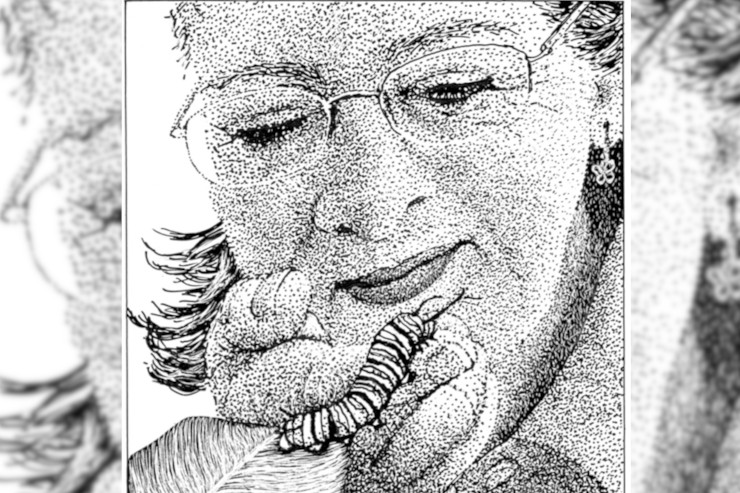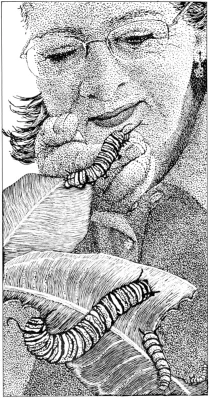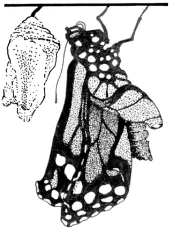
There are some interesting relationships in nature. For example, plants nourish birds by giving them seeds to eat. In return, birds spread those seeds, ensuring the plants flourish. Some relationships are far more exclusive, however, such as the relationship between the Tropical Milkweed and a very specific garden caterpillar.
The larvae of the Monarch butterfly will only eat Milkweed, making this plant vitally important for the Monarch’s survival. So when Linda Delmont and her daughter passed a group of students concerned about the destruction of Monarch habitats, they took two packets of Milkweed seeds to plant in their backyard.
In today’s story, My Private Microcosm, Linda shares the joy of watching Monarch butterflies, with their “velvety orange wings,” alight on the Milkweed. Soon thereafter, she notices the distinctive garden caterpillar, with black, yellow, and green stripes. She shares with us the joy she experienced watching these caterpillars grow and form chrysalises.
And as the Milkweed spread, so did her microcosm of “ladybugs, bees, funny orange beetles that sunbathed in clumps on the pods like tourists on a beach—and monarchs.” Then things took a turn, and “nature revealed her dark side.”
What happened to the Monarch butterflies? Did the Milkweed go awry? And what happened at Santa Barbara’s Ellwood Park? That’s where this all starts to come together, but I’ll let Linda tell the story as only she can.
Whether a Garden Caterpillar, a Wayward Dog, or a Cautious Cat, You’ll Find Plenty of Animal Stories
This story comes from our archive that spans over 30 years, and includes more than 130 magazine issues of GreenPrints. Pieces like these that turn gardening stories into everyday life lessons always brighten up my day, and I hope this story does for you as well. Enjoy!

My Private Microcosm
Monarchs, milkweed—and me.
By Linda Delmont
I didn’t know when I received the seeds what they’d bring.
My daughter and I were walking our dogs in Huntington Beach, California, when we came across school kids offering envelopes of free seeds: “Asclepias curassavica—Tropical Milkweed. The host plant for the monarch butterfly.” A sign explained that their habitat was being wiped out by builders. The students had started a project to encourage residents to plant the only food the caterpillar eats.
“Cool,” my daughter said and took two packs.
The seeds grew, and in a few months I had four one-foot milkweed plants in our backyard. One day I noticed a butterfly on one of the plants. I was reminded of the movie Field of Dreams: If you plant it, they will come. How had it found my tiny stems? I stared in wonder at the velvety orange wings with their black outline and white dots.
In early December, I spotted two black-, yellow-, and green-striped caterpillars munching on a plant. After that I watched them daily until the larger one stopped eating and hung itself in a “J” from a leaf. In a day or two, it wriggled its way out of its skin and formed a shiny green chrysalis. Tiny gold dots lined the top, like jewels on a crown. I was enthralled.
Ten days later, the chrysalis began to darken. The next time I looked, a wrinkled butterfly hung from the clear, empty shell. As fluid from the insect’s bloated body pumped into the wet wings, they straightened. It basked in the sun, wings spread, absorbing the heat—and then it flew away.

The next season, many more arrived. My milkweed flowers had sown fluffy parachute-like seeds and planted themselves all over my yard. My backyard blossomed with orange milkweed flowers and the insects attracted to them: ladybugs, bees, funny orange beetles that sunbathed in clumps on the pods like tourists on a beach—and monarchs. Inspired, I planted butterfly bush, lantana, and bright verbenas for the butterflies to feed on.
Then nature revealed her dark side. One day I noticed a caterpillar oozing green goo and writhing in agony. When I caught a wasp stinging a big caterpillar, I ran to Yahoo and discovered wasps suck proteins from the guts of other insects.
“You have to help me kill these things,” I told my husband.
“You have to stop interfering with Mother Nature. Everything eats something. It’s the law of the land.”
“Not in my garden.”
“Tell that to your hens next time they eat a grub.”
Seeing that he wasn’t going to be much help, I tried every trick I could find. Pretty beehive-shaped wasp traps from World Market. A plastic bag-thing from Home Depot. Home remedies like drier sheets. When nothing worked, my husband finally felt sorry for me and built a cage from PVC pipe and screen. I placed it over a clutch of plants. Safe from wasps, the caterpillars complacently munched and formed chrysalises on the wood top.
But the dark side isn’t so easily subdued. One sunny day, I found eight pairs of wings on the ground. Back to the web: Spiders love to eat soft bodies. Angrily I started squishing spiders.
“I think it’s time you found another hobby,” my husband said when he saw how upset I got. “What’s the point?”
“I’m just trying to give them a chance to become something better!”
“Is this something personal?” he said.
“Maybe.”
By this time, most of the gifts I got—monarch garden statue, wind chimes, watch, T-shirt, and necklace—reflected my obsession: I had become the Crazy Caterpillar Lady, a name coined by my son who, like my daughter, would soon be going off to college. I was still mourning my father’s passing; I felt left behind. Was this why protecting butterflies was so important to me?
It was a battle with endless opposing soldiers. A few months after the spider massacre, a rat chewed a hole in the enclosure and ate twenty larvae. I bought a trap, which caught its nose. It bounced around on the lawn like a Mexican jumping bean.
“Smash it with a shovel,” I told my husband.
“I can’t do that. He escaped death. He deserves to live.”
He freed it, but my pug found the rat a few days later, stiff beneath a bush. Dumping it in the trash, I felt depressed about so many deaths. My garden had become too much like the world I refused to watch on the nightly news. I couldn’t do this anymore. I picked up the shovel, determined to clear out all traces of the weed and plant carnations instead. Or geraniums—something that doesn’t attract insects.
But instead of uprooting the plants, I somehow ended up down on my knees, searching the underside of leaves for eggs to save.
For the past couple of years, I’ve raised the monarchs inside. Caterpillars munch milkweed in containers on my counter; I pick a hearty supply of leaves for them to eat every morning and change the napkin they poop on, like a diaper, every evening. I pet them like pup-pies. They make chrysalises on rectangles of cardboard that I clip in a pop-up “butterfly pavilion.” Every time I see them hatch out and fly, I’m still amazed.
In January, my husband, daughter, and I make a trip to Santa Barbara’s Ellwood Park to observe wintering monarchs. We stare at 34,000 monarchs hanging in thick clumps from the branches of the eucalyptus, wings folded like tiny paper fans. A few scattered butterflies dance in the rays of the grove’s filtered sunlight.
“Maybe some of these butterflies are yours,” my daughter says. She’s the one who had stumbled upon the site just a few miles from her college.
“Maybe. Where do most of them come from?” I ask the docent, a short, elderly man dressed in a black vest like a sheriff.
“From west of the Rockies. Arizona, New Mexico, Utah. In another month they’ll head north towards the Sierras and lay their eggs on milkweed along the way.”
When I tell him that 130 miles south in my garden in Orange County, I see monarchs flying just about any day the sun comes out, he comments, “Sounds like what you have is your own private microcosm. If they come to an area where it never freezes and the food is plentiful, they stay.”

My own private microcosm.
“We call her the Crazy Caterpillar Lady,” my husband tells the docent. They both laugh, but I don’t mind.
Eyes transfixed by the wonder before me, wearing my monarch T-shirt and watch, I smile—finally proud of my title, my toils, and the many blessings bestowed on me by backyard butterflies. ❖
By Linda Delmont, published originally in 2015, in GreenPrints Issue #104. Illustrated by P. Savage

Do you have any similar stories about things you’ve learned in your garden?




This story reminded me of my sister, Frankie, who loved Monarchs. Had butterfly weed and other plants and participated in a butterfly count each year. She was a member of the Butterfly Society. We lost her last April. I miss her so much, and will plant some milkweed this year again for her.